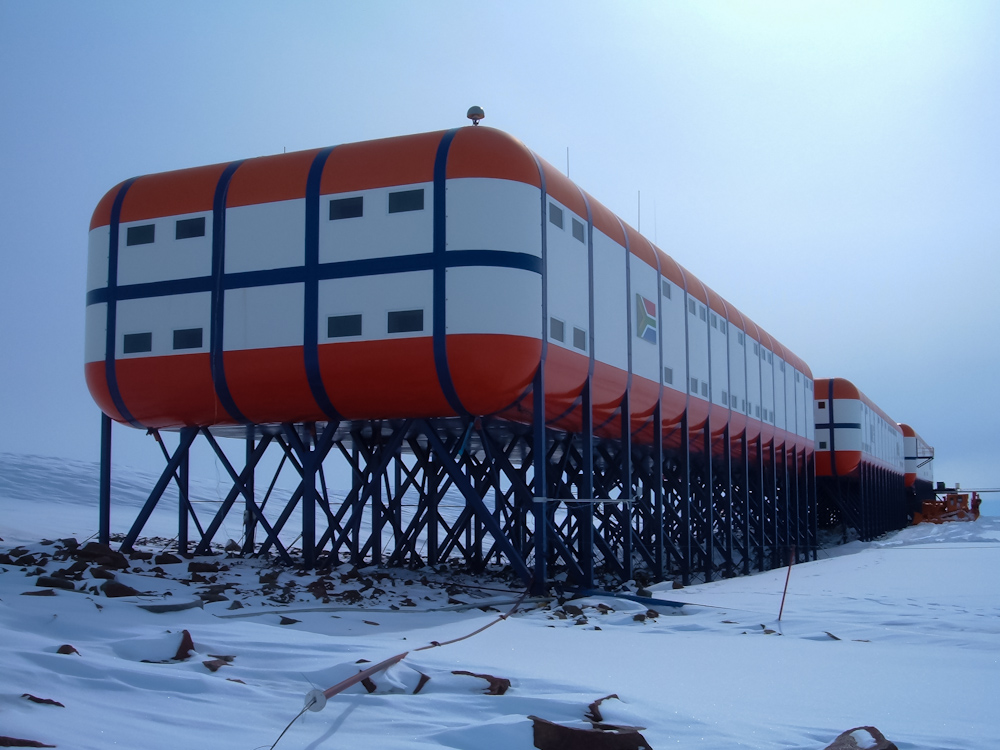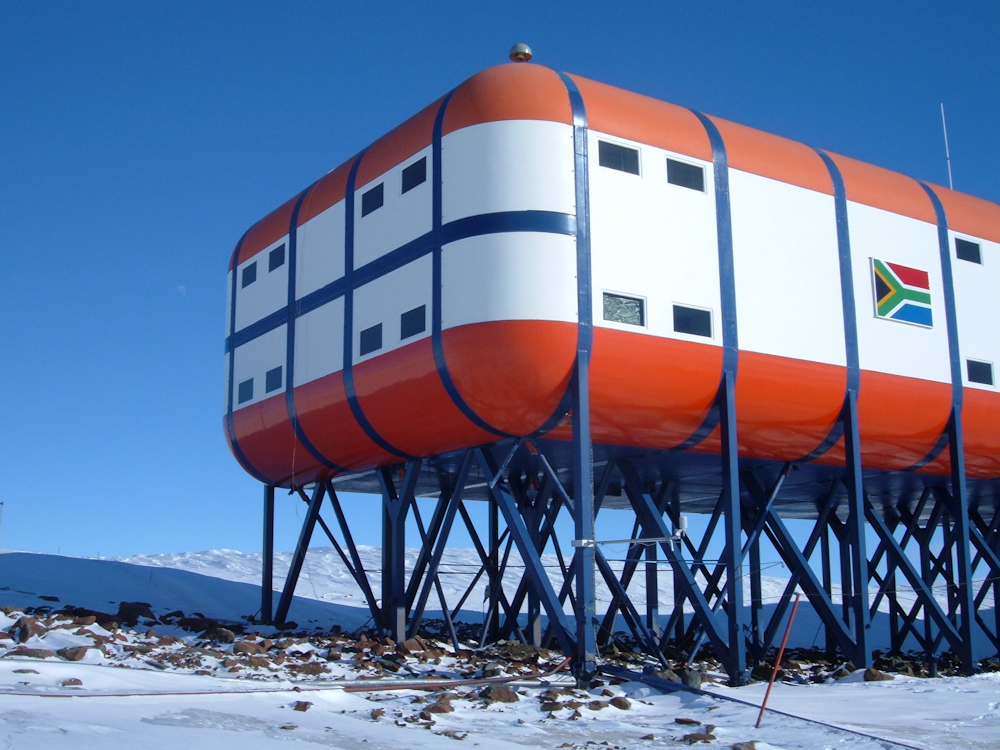A contribution which I wrote for Antarctica and the Arctic Circle: A Geographic Encyclopedia of the Earth’s Polar Regions.

South Africa is one of the founding signatories of the Antarctic Treaty of 1959. In 1960, the first South African National Antarctic Expedition (SANAE) team overwintered at the Norwegian base on the Fimbul Ice Shelf. A new base, SANAE I, was constructed nearby (70° 18′S 2° 22′W) and opened in 1962. Later bases, SANAE II and SANAE III, were built on the same location (72° 40′ 22″S 2° 50′ 26″W) and commissioned in 1971 and 1979 respectively. SANAE I and II were simple wooden structures with a limited life span. SANAE III was more robust, housed in horizontal corrugated steel cylinders. However, as SANAE III disappeared beneath the accumulating snow, it was subjected to crushing pressure and ultimately abandoned in 1994. The current South African research station, SANAE IV (72° 40′ 22″S 2° 50′ 26″W), is located in the Norwegian territorial claim of Queen Maud Land, some 90 miles (150 km) from the edge of the ice shelf. In contrast to earlier bases, which were built on the ice shelf, SANAE IV is perched at an altitude of 2,800 ft. (850 m) above sea level on top of the sloping plateau of Vesleskarvet, an isolated nunatak on the edge of the Ahlmann mountain range.
SANAE IV was completed in 1997 with a designed life span of about 25 years. It was built to withstand temperatures as low as −67°F (−55°C) and wind speeds up to 155 mph (250 km/h). Most of SANAE IV was prefabricated in South Africa. The structure consists of a steel framework cladded with thick foam and fiberglass composite panels. The base is about 575 ft. (175 m) long with three linked modules, each of which is 144 ft. (44 m) long, 46 ft. (14 m) wide, and has two interior levels. The southern module, A-block, contains accommodation, ablution facilities, a laundry, radio room, hospital, and various offices, laboratories, and storerooms. B-block houses further accommodation and ablution facilities, another laundry, the kitchen and dining area, cold and dry stores, library, and entertainment areas. Finally, C-block contains the diesel generators, water storage and sewage processing plant, storerooms, engineering offices, gymnasium, sauna, and a helicopter hangar.
SANAE IV is elevated 13 ft. (4 m) above the surface on steel stilts, securely anchored into exposed rock. The elevated structure accelerates snow blowing through beneath the base. Since SANAE IV is located near the edge of a cliff, which is downwind of the prevailing wind direction, most of the snow that might have accumulated in the lee of the base has been blown over the cliff.
The base is powered by three 250 kW diesel generators. The internal temperature of the living areas is maintained using heat from the generators’ exhausts. Potable water is produced by a snow smelter located a small distance from the base and which must be regularly filled with fresh snow. SANAE IV has a sophisticated communications infrastructure based on HF radio and satellite systems. The satellite connection provides telephone, fax, and Internet links. The operation of SANAE IV emphasizes environmental responsibility, and every effort is made to prevent contamination of the local environment. All waste material is sorted and then returned to South Africa for disposal or recycling.
SANAE IV can accommodate around 80 people during the summer relief period and up to 18 overwintering team members. The overwintering team typically consists of two or three scientists, a meteorologist, two diesel mechanics, electronic, electrical and mechanical engineers, and a doctor.

It is possible to fly from Cape Town to a blue ice runway near SANAE IV, but the costs are prohibitively high. Personnel, supplies, and equipment normally reach SANAE IV by sea. The annual relief voyage departs from Cape Town around the beginning of December every year and returns toward the end of February the following year. The SA Agulhas, the ship that has serviced SANAE bases since 1978, was replaced by the new SA Agulhas II in 2012. Once the supply ship reaches the ice shelf, personnel and sensitive equipment are airlifted to the base by helicopter, while the remaining cargo is transported over land by caterpillar train.
The base hosts a number of high-profile science projects. During the summer months, research is conducted in biology, renewable energy, geology, and geomorphology. Research in the physical sciences extends throughout the year, and a range of sophisticated experiments operate continuously in the vicinity of the base, such as the following: (1) the motion of ionospheric irregularities is measured by the Southern Hemisphere Auroral Radar Experiment (SHARE), a 16-element high-frequency coherent radar array. The radar can also detect the trails of ionization from meteors. The SHARE radar forms part of the Super Dual Auroral Radar Network, operating in conjunction with other radars on the continent. The field of view of the SHARE radar overlaps with those from the radars at Halley and Showa stations. The direction and velocity of ionospheric convection can be determined where the fields of view from two or more radars overlap; (2) properties of the magnetosphere are deduced from very-low-frequency (VLF) radio wave measurements made using a pair of orthogonal loop antennas. VLF waves originate from lightning activity and natural processes in the magnetosphere. The VLF system also contributes data to the World Wide Lightning Location Network; (3) the proportion of electromagnetic waves that are absorbed by the ionosphere is measured by a 64-beam imaging riometer, which monitors the radio noise originating from deep space; (4) the earth’s absolute magnetic field strength, as well as fluctuations in the field, are measured using magnetometers; (5) a dual-frequency GPS receiver measures the total electron content of the ionosphere; (6) a scintillation monitor detects rapid fluctuations in GPS signals that are caused by small-scale irregularities in ionospheric density; (7) the flux of galactic and solar cosmic rays are studied using neutron monitors; and (8) a satellite telemetry station, which was installed for the Astrid 2 Swedish microsatellite, provides data downlink facilities. (9) A complete range of meteorological instruments supply weather data.